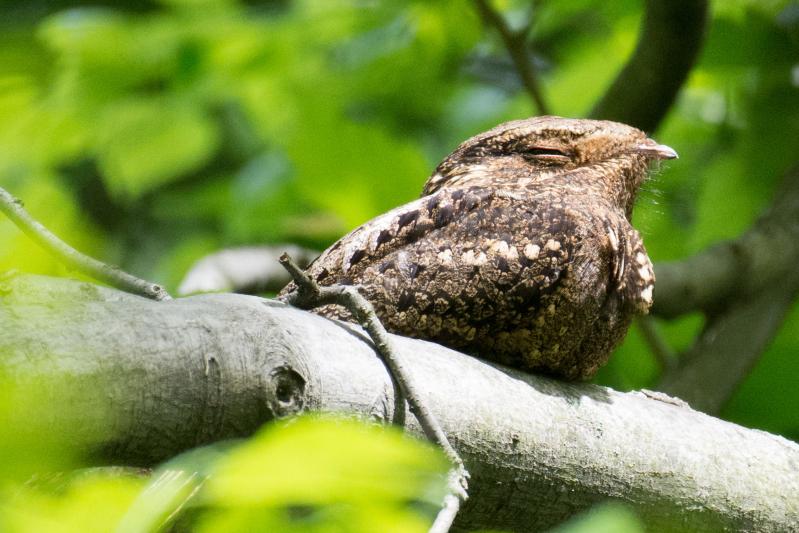Wednesday evening was warm and still when I pulled out of my driveway at 8:40 and headed toward Montauk. I got to the railroad bridge on Cranberry Hole Road in Amagansett at 9:05, stopped on the other side, put my earphones on, turned on my EasyHear, and listened. Nothing but locusts.
I had picked this back road to Montauk because I had heard there were whippoorwills there. I drove along slowly, stopping every quarter mile to listen all the way to the west side of Napeague Harbor, and then back through Promised Land. I didn’t hear a single whippoorwill call. I decided to try Napeague Harbor Road, and as soon as I turned onto it, I heard my first whippoorwill call of the season, so close that I didn’t need my elaborate hearing apparatus, just my naked ears. It was coming from a patch of pitch pines and scrub oaks, an area I knew well from my lady-slipper-seeking days.
I hung around for another five minutes and may have heard a second one in the distance to the east. My spirits soared as I turned onto Napeague Harbor Road from Montauk Highway. As soon as I reached the private road that goes off the east not far from the shore, I heard another one. Finally, I drove halfway down to the Walking Dunes trail, stopped and heard another call that went on for two or three minutes or more without a break, “whip-poor-will, whip-poor-will, whip-poor-will . . . whip-poor-will,” at which point I pulled a 180 and returned to Montauk Highway, stopping once to listen near the railroad tracks, where six years ago I heard a close whippoorwill relative, Chuck-will’s-widow, an uncommon nightjar on Long Island.
It was already 10:30 and I hadn’t even reached Montauk, the main objective of my search. Would I be too late? I covered two-thirds of Montauk, starting with Old Montauk Highway east of the “Polo Field” at 10:48. When I finally got to the Navy Road end, where whippoorwills had been heard year after year, it was already 11:43. I hung around for 10 minutes and didn’t hear a thing. Too late, I said to myself. I turned around and went home. Going and coming I heard the usual gray tree frog tremolos wherever a wetland lay near the road, and at least 10 does, loners, except for one twosome, feeding on the vegetation at the edge of the roads, not at all alarmed by my passing by so closely.
I emailed Stephanie Krusa of Third House Nature Center in Montauk, who is a regular Navy Road whippoorwill listener, and told her I had heard nothing. She went to Navy Road the next evening at dusk, and emailed me
Whippoorwills were once common throughout the woods of Southampton and East Hampton, especially in Wainscott, which is the center of the South Fork’s oak and pitch pine forest. As East Hampton Airport has grown more active with each passing year, they have become fewer and fewer. Only in June of last year, while a curfew limiting flight activity was still in place, I heard three different whippoorwills one evening northeast of the airport along Daniel’s Hole Road.
It has been observed by ornithologists and birdwatchers that the eggs hatch out a day or two before the full moon. The look-alike Chuck-will’s-widow with the loud distinctive repetitive call is working its way north slowly as the mockingbird, red-breasted woodpecker, and Carolina wren did before it. It likes wetter areas, but like the whippoorwill, it is most active at dusk, never calls during the day, and helps incubate the eggs, of which there are always two. The poor-will of the Southwest and West is similar in aspect, but has a monotonic tremolo call quite similar to the screech owl’s song.
The nighthawk that breeds farther to the north, up to the Arctic Circle, and migrates deeply into South America come the fall is another in the insectivorous goatsucker family. We only see it locally when it passes through in midspring and very early fall.
Eurasia has another member of the small goatsucker family, the nightjar, which has a “jarring” call. It is believed that the name goatsucker comes from the nightjar’s penchant for hanging around stock farms where insects are generally bountiful. Ironically, perhaps, on that same night I heard the three whippoorwills calling on Napeague, the car I was sitting in with the windows open filled with mosquitoes.
I just received an email from Stephanie, who had just returned
from Eddie Ecker Park at the end
of Navy Road and was ecstatic, having heard four different whippoorwills wailing away. So if you’ve never heard a whippoorwill calling nonstop, over and over, and you would like to hear one, you now know where to go.
You’ll be in very good company.
Larry Penny can be reached via email at [email protected].

